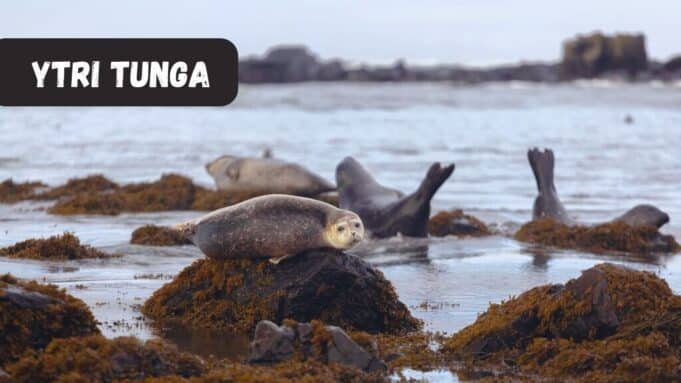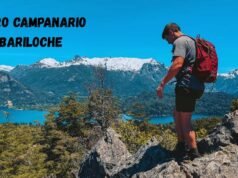Tucked away on the southern edge of Iceland’s Snæfellsnes Peninsula, Ytri Tunga is a peaceful yet striking destination that combines golden sands with a lively seal colony and stunning coastal scenery.
While it’s not as famous as other Icelandic attractions, Ytri Tunga offers a unique experience—especially for wildlife lovers and those seeking a quieter escape from the tourist crowds. With its photogenic setting and easy access, it’s a must-visit stop for anyone exploring the peninsula.
Location and Accessibility of Ytri Tunga
Ytri Tunga is located about 170 kilometers (roughly 2 to 2.5 hours by car) northwest of Reykjavík. It sits just off Route 54, the main road that circles the Snæfellsnes Peninsula. This makes it easily accessible for day-trippers and those touring the region.
A small sign indicates the turn-off, and a short gravel road leads to a parking lot near the beach. From there, visitors follow a simple walking path through low dunes and grassy meadows, offering immediate immersion into the area’s tranquil environment.
Geological and Scenic Appeal of Ytri Tunga
Unlike most Icelandic beaches characterized by their dark volcanic sand, Ytri Tunga surprises visitors with its pale golden shores. This distinctive color originates from a blend of crushed seashells and light-colored minerals, shaped over centuries by the erosive forces of the ocean.
The contrast between the warm-toned beach and the deep blue waters of the Atlantic is visually striking. On clear days, the view extends to the majestic Snæfellsjökull glacier in the distance, adding a dramatic alpine backdrop. Coastal cliffs and moss-covered lava fields complete the stunning landscape, offering endless photo opportunities.
Related: Scuba Diving on a Komodo
Seal Watching: Wildlife at Play
Ytri Tunga is perhaps best known for its thriving seal population. Seals can often be spotted lounging on the black volcanic rocks that line the shore or swimming just offshore in the shallow waves. The most common species are harbor seals, which are smaller and have round faces, and grey seals, which are larger with long noses and speckled fur.
During the summer months—from May through August—seal activity peaks, especially during low tide when the rocks are fully exposed. It’s one of the most reliable places in Iceland to see these animals in the wild, making it a favorite stop for wildlife photographers and nature enthusiasts.
Ytri Tunga Responsible Wildlife Viewing

While the seals at Ytri Tunga are accustomed to human presence, it’s essential to approach the area with respect. Visitors should stay at least 50 meters away from the animals, avoid sudden movements or loud noises, and never block a seal’s access to the ocean.
Seal pups, in particular, are vulnerable to stress caused by human interaction. Signs near the parking area provide guidelines for respectful behavior, and wooden posts help mark safe viewing distances. These measures not only protect the animals but also ensure a more authentic and rewarding experience for visitors.
READ: Molokini Is The Best Snorkeling Spot In Hawaii
Ytri Tunga Beach, Iceland
Ytri Tunga Beach is one of Iceland’s most charming and lesser-known coastal destinations, located on the southern edge of the Snæfellsnes Peninsula. What sets this beach apart from most Icelandic coastlines is its light golden sand, a rare sight in a country known for its black volcanic shores.
This picturesque setting offers views of the open Atlantic Ocean and, on clear days, even the distant Snæfellsjökull glacier. The beach is peaceful and scenic, ideal for nature walks, photography, or simply soaking in the unique landscape. Its easy accessibility and tranquil ambiance make it a rewarding stop for travelers looking for authentic Icelandic coastal beauty without the crowds.
Ytri Tunga Seal Beach
Often referred to as Ytri Tunga Seal Beach, this location is one of the best places in Iceland for seal watching in the wild. The rocky outcrops just offshore are favorite resting spots for two primary species: harbor seals and grey seals. During the summer months, especially between May and August, visitors can reliably spot seals lounging on the rocks or swimming along the shore, particularly during low tide.
The seals at Ytri Tunga are relatively used to human observers, but it’s important to keep a respectful distance to avoid disturbing them. For wildlife photographers, this beach offers one of the most accessible and rewarding places to capture natural seal behavior in their native environment.
Ytri Tunga Beach Parking
Parking at Ytri Tunga Beach is simple and free. Located just off Route 54, there’s a marked turnoff leading to a small gravel parking area near the beach. From the parking lot, a short walking trail leads through grass-covered dunes and opens onto the sandy shore, making it easy for visitors of all ages to access the beach and seal viewing areas.
There are no formal facilities like restrooms or shops at the parking area, so it’s recommended to come prepared. The space typically accommodates several vehicles comfortably, but during peak summer hours, it can fill quickly—arriving early or visiting in the morning or evening can help you avoid crowds and enjoy a quieter experience.
Read More: How to Visit the Galapagos Islands
Beyond the Beach: Surrounding Attractions
Ytri Tunga is just one gem among many on the Snæfellsnes Peninsula, often referred to as “Iceland in Miniature” due to its diverse landscapes. Nearby, visitors can explore Arnarstapi, a coastal village known for its dramatic cliffs and sea arches, or hike into Rauðfeldsgjá, a hidden mountain gorge with a small waterfall inside.
The peninsula also offers lava fields, volcanic craters, and charming fishing villages like Stykkishólmur. Whether you’re on a day trip or a longer journey, Ytri Tunga fits beautifully into a well-rounded Icelandic itinerary.
Practical Visit Tips
- Getting There: Drive from Reykjavík along Route 1 and turn onto Route 54. Watch for the Ytri Tunga sign around 10 minutes east of Búðir.
- Best Time to Visit: Late spring to mid-summer (May to July) is ideal for seal sightings and mild weather. Mornings or late evenings offer softer light for photography.
- What to Bring: Binoculars or a zoom lens, windproof layers, and waterproof footwear. There are no food or restroom facilities on-site, so come prepared.
- Safety Note: Be cautious on wet rocks and avoid disturbing the seals. Stay on marked paths to protect local vegetation and avoid hidden holes in the lava field.
Why Ytri Tunga Stands Out?
In a country filled with dramatic waterfalls and volcanic wonders, Ytri Tunga offers something simpler yet equally compelling: a quiet moment to connect with nature. Whether you come to photograph the seals, enjoy the golden sand under your feet, or simply sit and watch the ocean, Ytri Tunga delivers a serene and rewarding Icelandic experience. It’s a place where wildlife and wilderness coexist peacefully—and where visitors are invited to slow down and take it all in.
Read Also: Diamond Beach, Iceland
What Makes Ytri Tunga Different from Other Beaches in Iceland?
Ytri Tunga stands out for its golden sands, which are a rare sight in Iceland, where most beaches are composed of dark volcanic rock and ash. The sand at Ytri Tunga comes from marine sediment, including light-colored crushed shells and minerals, creating a soft and warm-toned beach that offers a visual break from Iceland’s more dramatic black sand coastlines. Additionally, what truly sets Ytri Tunga apart is its resident seal population.
Unlike most beaches that draw visitors primarily for scenery, this location offers an accessible and consistent opportunity to observe seals in their natural habitat. Combined with the stunning views of the Snæfellsjökull glacier in the distance, Ytri Tunga offers a serene yet dynamic experience that mixes landscape, wildlife, and photographic potential.
When Is the Best Time to Visit Ytri Tunga for Seal Watching?

The ideal time to visit Ytri Tunga for seal watching is during the summer months—from May to August. During this period, seal activity is at its peak, as the animals are more frequently seen sunbathing on the exposed rocks or swimming close to the shore. Low tide is especially favorable because it reveals more of the rocky outcrops where seals like to rest.
Planning a visit around the tidal schedule significantly increases your chances of spotting them. For photographers and nature lovers, early morning and late evening not only offer the best light but also provide a quieter atmosphere, free from larger tourist groups. Though seals can occasionally be seen during other times of the year, summer remains the most reliable and rewarding season.
How Close Can You Get to the Seals at Ytri Tunga?
While the seals at Ytri Tunga may seem relaxed and used to human presence, it’s essential to maintain a safe distance of at least 50 meters (165 feet). This is especially important when seal pups are present, as proximity can disturb the animals and stress mothers into abandoning their young. The area has clear signage and marked footpaths to help visitors navigate safely without encroaching on the seals’ space.
Using a telephoto lens or binoculars allows for intimate observation and photography without disturbing the animals. Respecting this boundary ensures not only a positive wildlife experience for future visitors but also the long-term health and safety of the seal colony.
Also Read: Sky Lagoon Iceland
Is Ytri Tunga Suitable for Families and Children?
Absolutely—Ytri Tunga is a wonderful destination for families, especially for children with an interest in animals and nature. The short and flat walking path from the parking area makes it easily accessible for young kids and even strollers. Children can enjoy watching the seals, exploring the sandy beach, and learning about Icelandic wildlife in a hands-on environment.
However, the rocky shoreline and tidal pools can be slippery, and parents should ensure that children are supervised at all times, especially near the water. Since the site lacks facilities such as toilets or food stands, families should come prepared with snacks, water, and appropriate clothing for the variable coastal weather.
Are There Any Facilities or Tours at Ytri Tunga?
Ytri Tunga remains a natural, undeveloped site, meaning there are no on-site facilities such as restrooms, shelters, or cafés. Visitors should plan by using facilities in nearby villages like Búðir or Arnarstapi. Some local tour companies include Ytri Tunga as a stop on guided day tours of the Snæfellsnes Peninsula, often combined with visits to nearby attractions like the Snæfellsjökull glacier or the fishing village of Stykkishólmur.
While the majority of travelers choose to explore the site independently by car, joining a guided tour can offer additional context about the region’s ecology and history, enhancing the overall experience.
Is Ytri Tunga Worth Visiting?
Yes, Ytri Tunga is worth visiting, especially if you’re exploring Iceland’s Snæfellsnes Peninsula or enjoy peaceful nature experiences. Here’s why it stands out:
1. Reliable Seal Watching
Ytri Tunga is one of the most dependable places in Iceland to see seals in the wild. The rocky shore provides an ideal habitat, and during summer—particularly from May to August—you’re likely to see harbor and grey seals sunbathing or swimming.
2. Unique Golden Sand Beach
Unlike Iceland’s common black sand beaches, Ytri Tunga features golden sands, giving it a softer, more inviting look. It’s a beautiful contrast against the Atlantic waves and the backdrop of Snæfellsjökull Glacier.
3. Quiet and Uncrowded
Ytri Tunga is a hidden gem, often overlooked by mass tourism. That means you can enjoy the scenery and wildlife in a peaceful, less commercialized setting, perfect for relaxation, reflection, or nature photography.
4. Easy Access
Located just off Route 54, the beach is easy to reach by car, with free parking and a short, level walk to the coast. It’s a great stop for all ages and fits nicely into a road trip around the peninsula.
5. Ideal for Photographers and Nature Lovers
Whether you’re into wildlife photography, landscape shots, or just love observing nature in a serene environment, Ytri Tunga offers ample visual and emotional rewards.
Verdict:
If you’re traveling through the Snæfellsnes Peninsula or seeking a calm, wildlife-rich destination, Ytri Tunga is worth the visit. It may not have flashy attractions, but its beauty lies in its simplicity, natural charm, and unforgettable seal encounters.
To Know More: Iceland Tectonic Plates Diving Tours
Can You Camp or Stay Overnight Near Ytri Tunga?
While wild camping is not permitted directly on the beach or in the immediate area, there are several comfortable accommodation options nearby. Travelers can choose from campsites, guesthouses, cabins, and farm stays within a 10–30 minute drive. Some of the most popular places to stay include the quaint coastal towns of Hellnar, Arnarstapi, and Ólafsvík, which offer a range of lodging options from rustic to more modern accommodations.
Staying overnight in the region also gives you the chance to explore the broader Snæfellsnes Peninsula at a relaxed pace, with attractions such as lava fields, sea cliffs, and historic sites just a short drive away.
Conclusion: A Peaceful, Authentic Slice of Iceland
Ytri Tunga stands apart not with grandeur, but with serenity. It’s a place where the wildness of Iceland’s coastline meets the stillness of a quiet beach, where golden sands blend into sea-washed rocks, and seals rest undisturbed by the rush of the world.
Whether you’re a photographer, a nature lover, or simply someone looking to pause and soak in a moment of unspoiled beauty, Ytri Tunga delivers an unforgettable experience. For those venturing along the Snæfellsnes Peninsula, this tranquil beach promises a deep connection to Iceland’s untamed charm.















